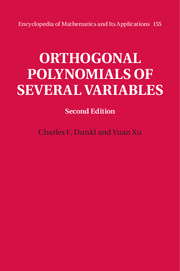Book contents
- Frontmatter
- Contents
- Preface to the Second Edition
- Preface to the First Edition
- 1 Background
- 2 Orthogonal Polynomials in Two Variables
- 3 General Properties of Orthogonal Polynomials in Several Variables
- 4 Orthogonal Polynomials on the Unit Sphere
- 5 Examples of Orthogonal Polynomials in Several Variables
- 6 Root Systems and Coxeter Groups
- 7 Spherical Harmonics Associated with Reflection Groups
- 8 Generalized Classical Orthogonal Polynomials
- 9 Summability of Orthogonal Expansions
- 10 Orthogonal Polynomials Associated with Symmetric Groups
- 11 Orthogonal Polynomials Associated with Octahedral Groups, and Applications
- References
- Author Index
- Symbol Index
- Subject Index
Preface to the First Edition
Published online by Cambridge University Press: 05 August 2014
- Frontmatter
- Contents
- Preface to the Second Edition
- Preface to the First Edition
- 1 Background
- 2 Orthogonal Polynomials in Two Variables
- 3 General Properties of Orthogonal Polynomials in Several Variables
- 4 Orthogonal Polynomials on the Unit Sphere
- 5 Examples of Orthogonal Polynomials in Several Variables
- 6 Root Systems and Coxeter Groups
- 7 Spherical Harmonics Associated with Reflection Groups
- 8 Generalized Classical Orthogonal Polynomials
- 9 Summability of Orthogonal Expansions
- 10 Orthogonal Polynomials Associated with Symmetric Groups
- 11 Orthogonal Polynomials Associated with Octahedral Groups, and Applications
- References
- Author Index
- Symbol Index
- Subject Index
Summary
The study of orthogonal polynomials of several variables goes back at least as far as Hermite. There have been only a few books on the subject since: Appell and de Fériet [1926] and Erdélyi et al. [1953]. Twenty-five years have gone by since Koornwinder's survey article [1975]. A number of individuals who need techniques from this topic have approached us and suggested (even asked) that we write a book accessible to a general mathematical audience.
It is our goal to present the developments of very recent research to a readership trained in classical analysis. We include applied mathematicians and physicists, and even chemists and mathematical biologists, in this category.
While there is some material about the general theory, the emphasis is on classical types, by which we mean families of polynomials whose weight functions are supported on standard domains such as the simplex and the ball, or Gaussian types, which satisfy differential–difference equations and for which fairly explicit formulae exist. The term “difference” refers to operators associated with reflections in hyperplanes. The most desirable situation occurs when there is a set of commuting self-adjoint operators whose simultaneous eigenfunctions form an orthogonal basis of polynomials. As will be seen, this is still an open area of research for some families.
- Type
- Chapter
- Information
- Orthogonal Polynomials of Several Variables , pp. xv - xviiiPublisher: Cambridge University PressPrint publication year: 2014



